You found our list of Asian Pacific Heritage Month ideas for work.
Asian Pacific Heritage Month is a US holiday celebrated during the month of May. The occasion honors Asian culture and the achievements of the Asian community within the United States and across the world. The month is also commonly known as “Asian Heritage Month”, “Asian American and Pacific Islander Heritage Month”, “APPI Month” and “Asian Awareness Month”.
This month is similar to Hispanic Heritage Month, Black History Month, and Arab American History Month.
You can honor the occasion with online team celebrations and by sharing Asian Pacific Heritage Month quotes with staff.
This post contains:
- how to celebrate Asian Pacific Heritage Month at work
- Asian Pacific Heritage Month activities & games
- virtual Asian Pacific Heritage month ideas
Here is the list!
List of ideas, games & activities for Asian Pacific Heritage month
From games to maps to employee spotlights, here are some of the best ideas for celebrating Asian Pacific Islander Heritage Month in the office.
1. Asian Heritage Month Trivia
Trivia is one of the best games to play with your team. This activity is equal parts fun and educational. Staff can learn about Asian culture, history, and achievements while collaborating and competing with coworkers.
There are a few ways to play Trivia:
- Read questions one by one and award points to the first team to answer in the chat box or by raising hands.
- Give teams a questionnaire to complete, and award points based on speed of completion and accuracy of answers.
- Make a quiz in Kahoot, and have participants play by entering the room pin code and answering via mobile device.
Here are some starter questions we made for your game:
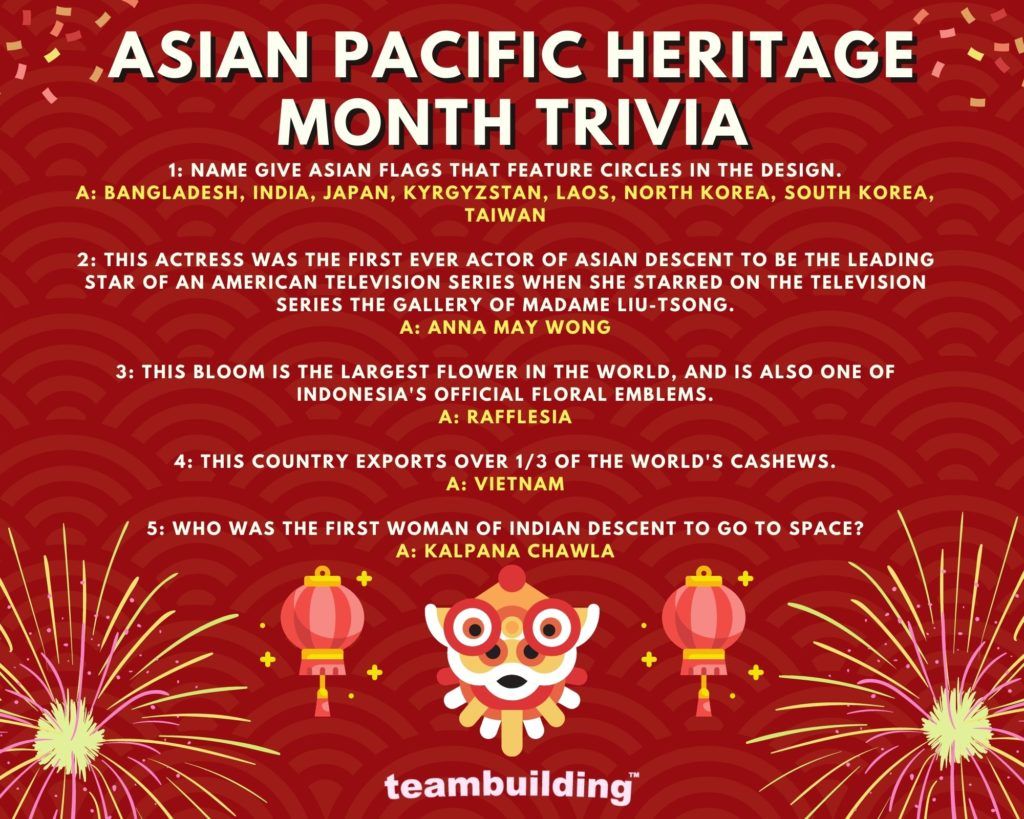
Read more tips for trivia.
2. Interactive map
Interactive maps serve as great icebreaker activities. This exercise highlights the different ties staff have to Asian countries. To start the activity, develop a map key with different symbols or colors representing personal links to countries.
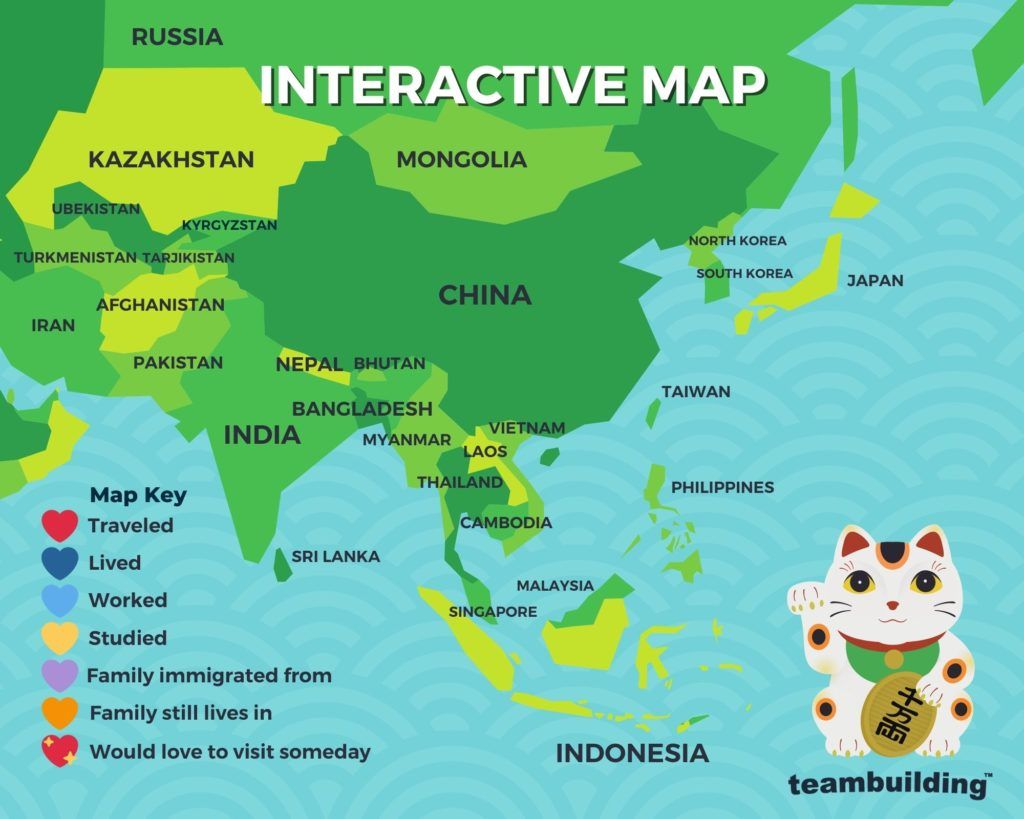
You could either ask each team member to create an individual map, or make one cohesive team map. When the map is complete, display it in a common area. These images can spark conversations or friendships between teammates.
3. Lunch and learns
Lunch and learns are short educational sessions that often involve question and answer segments, and are usually held during lunchtime. These seminars serve as professional development opportunities and employee engagement activities. Some lunch and learn subjects directly relate to work, while others revolve around entertainment or practical life skills.
Hosting themed lunch and learns during Asian Pacific Heritage Month is a way to clear up misconceptions and share information about lesser known aspects of Asian culture.
Here are a few topic ideas for Asian Heritage Month:
- Modern Whitewashing and Asian History in Hollywood
- Art of War and Business Strategy
- Asian Business Practices and Etiquette
- East Meets West: How Cultural Norms Impact Coworker Interactions
- Asian Inventions and Inventors
- The Professional: A History of Asians in Unlikely Industries
The topic options are limitless. For more inspiration, poll your staff, research online, or reach out to speakers.
To host a lunch and learn, set a date and time, pick a speaker and topic, and then invite employees to an in-person lecture or Zoom meeting. If booking a speaker is not an option, then you can recruit a teammate to present or watch a video lecture.
Here are virtual lunch & learn ideas you can use.
4. Book club
One of the simplest ways to learn about the authentic Asian experience is to read books by Asian authors. These works empower members of the community to candidly tell important stories.
To host a book club, first decide on a title. Since professionals are busy, try to allow about a month between announcing the book and holding the meeting. Sending members a copy of the book or reimbursing purchases is a nice touch.
Here are a few reading recommendations:
- The Joy Luck Club by Amy Tan
- If They Come for Us by Fatimah Asghar
- Crazy Rich Asians by Kevin Kwan
- Little Fires Everywhere by Celeste Ng
- If I Had Your Face by Frances Cha
- Eat a Peach: A Memoir by David Chang
- Minor Feelings by Cathy Park Hong
Before the meeting day arrives, prepare talking points and questions. You may be able to find book club guides for your title by searching online, however, you can also leave discussion open-ended. Your group will meet up in person or on Zoom to share thoughts and impressions.
Check out more books to read at work.
5. Employee resource groups
This month-long occasion is not only about celebrating Asian culture in May, but supporting members of the community yearlong. Asian employees should feel respected and valued at work at all times. Employers can empower Asian team members by launching an employee resource group.
Employee resource groups are groups where team members of similar identities gather to share similar experiences and brainstorm about possible workplace improvements. These groups create spaces where employees can be fully themselves and find solidarity with peers. These gatherings provide employees with a sense of camaraderie, belonging, and psychological safety, and empower team members to advocate for their ideas and needs.
If the company does not have an employee resource group for Asian staff, then Asian Heritage month is a good time to introduce one. If the organization is too small to sustain such a group on its own, then connect interested staff with a broader industry or professional group.
6. Virtual tour
Booking a flight to Asia may be outside your team building budget. However, you and your team can take informative and engaging online tours of Asian museums, landscapes, and heritage sites.
Here are some destination suggestions:
- NYC Chinatown
- Cherry Blossoms Around the World
- Asian Art Museum
- Kyoto National Museum
- Wing Luke Museum
- Great Wall of China
- National Museum of Korea
- Taj Mahal
- Angkor Wat
- Thailand
- Vietnam Heritage Sites
Check out more online tours you can take with your team.
7. Care packages
Care packages are one of the best virtual Asian Pacific Heritage month ideas. These goodie boxes permit you to treat and nourish remote workers while supporting Asian entrepreneurs.
You can send gifts such as snacks, coffee and tea, stationery, and decor to your work from home employees. For maximum impact, include a card with information about the business, such as websites and social media handles, so that staff can visit the store in the future if they enjoy the products.
Here is a New York Magazine list of Asian and Asian-American owned brands to start your search, as well as more work from home gift options.
8. Remote dinners
Food plays a huge part in Asian culture, communal family meals especially.
In honor of the occasion, order a catered meal from an Asian-owned restaurant. If you manage a dispersed team, then reimburse teammates for takeout or delivery, and gather on video call to eat and talk together. We recommend trying out lesser-known cuisines such as Filipino, Cambodian, or Nepalese if possible. If these options are not available, then you could also cook dishes from scratch together on camera.
Check out this list of virtual cooking classes for more culinary inspiration.
9. Employee spotlight
Featuring Asian employees on social media or blog posts is a method of calling attention to the important roles these individuals play in the organization. Of course, you should always ask staff permission before posting.
Here are some questions you can use to structure your post:
- What does being Asian mean to you?
- What Asian figure do you think more people should know about?
- What is your favorite cultural tradition?
- What do you hope to see for the Asian community in coming years?
- What is your proudest career accomplishment to date?
- What is one professional goal you have for yourself?
- How do you make the Asian identity your own?
- What is one activity or dish from the Asian side of your culture that you think everybody should try?
- Beyond your Asian heritage, what other identities do you hold dear?
These are just a few examples of talking points to share in your content spotlight. You could also hand the reins to the account over to the featured team members for a content takeover.
10. Craft class
Asian art goes back thousands of years and spans many categories. Beyond the fine art featured in museums, many Asian cultures are master crafters. Craft classes make great group activities for Asian Pacific Heritage month.
To hold a craft class, pick a project, gather supplies, and choose a time to gather and create together. If holding the outing remotely, then send attendees a kit or supply list, and craft together on Zoom. We also recommend creating a photo gallery for finished products.
You can either find a teacher to lead the tutorial live, or watch a video on YouTube.
Here are some project suggestions:
- Origami
- Lantern-making
- Calligraphy
- Fan-painting
- Flower arranging
- Jewelry
- Weaving
- Washi-paper decorating
- Doll making
- Mask painting
- Pottery
The key to hosting any craft class is to pay homage to the root of the art and touch on the history. While these crafts are decorative and fun, they are also steeped in tradition.
Check out more online art classes.
11. Name the country challenge
There are around fifty countries in Asia. While China is easy to spot, only geographical whizzes can name and label all the countries on the continent.
To play the name the country challenge, give teams a blank map to label. We recommend setting a time limit, for example, ten minutes. Groups that complete the nations can name the capital cities. You could also use official dishes, famous landmarks, flags, or other national identifiers.
Here is a template we made for your game:
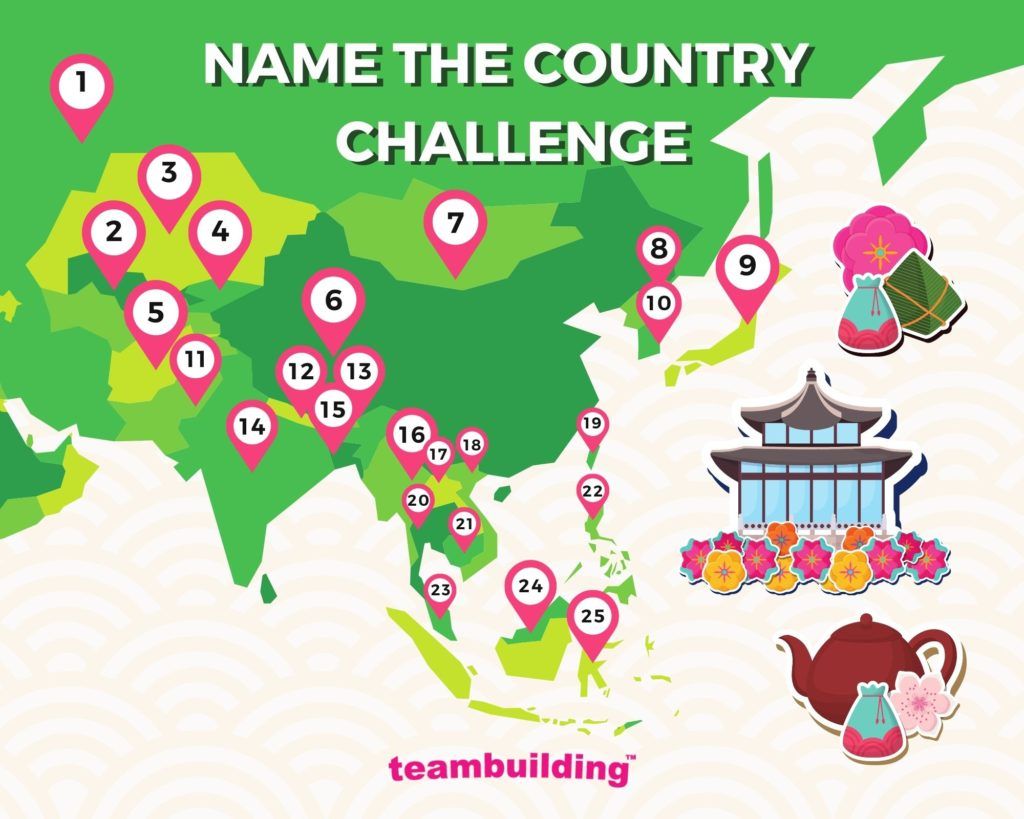
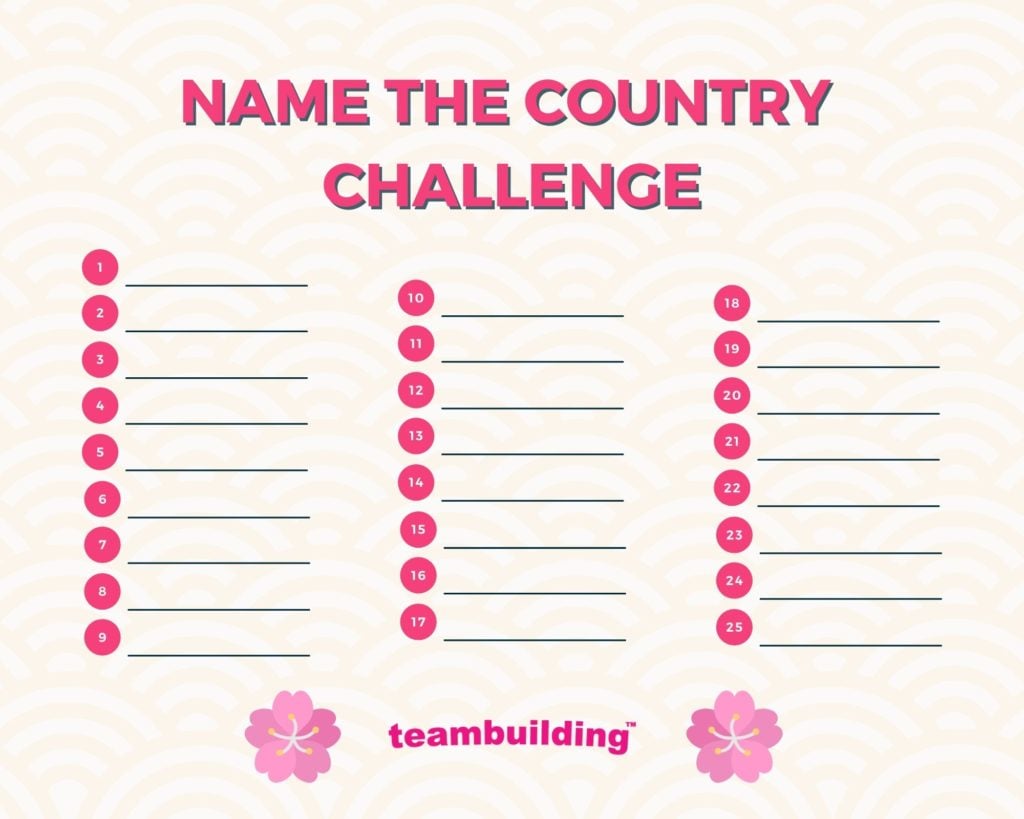
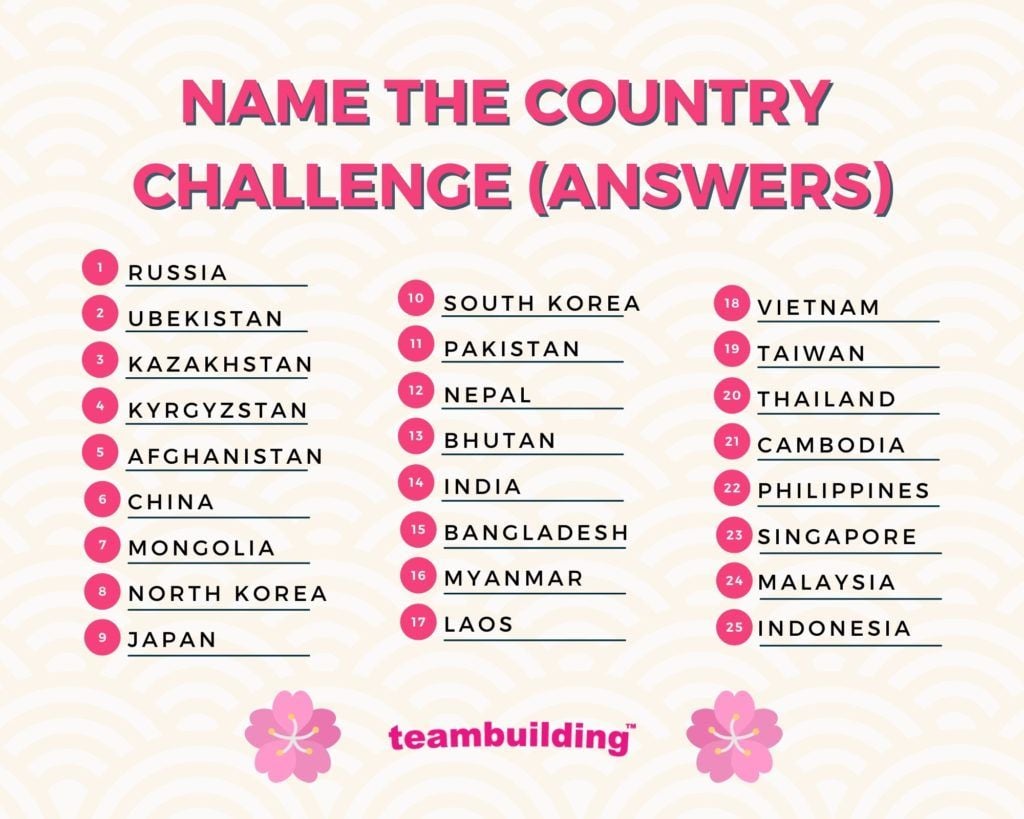
To make the activity easier, provide a list of all the countries without the assigned numbers, and for more of a challenge, have players can label completely from memory.
12. Movie Night
For Movie Night, simply choose a movie to screen or stream at a selected date and time. Perhaps show a different movie every Friday night. If you are showing movies in person, then you can project the films on a large screen and provide snacks. If your organization is remote, then use a group streaming feature like Netflix party or Watch2Gether to sync videos.
Here are some movie suggestions:
- Minari
- Parasite
- The Wind Rises
- The Joy Luck Club
- Crazy Rich Asians
- Flower Drum Song
- The Farewell
- Sunset at Chaophraya
- Tigertail
- The Lunchbox
There are many more films to feature. Bollywood alone produces between 1,000 to 2,000 movies each year, meaning you will never run short on options. You can also watch Asian-made TV shows like Midnight Diner or Korean dramas.
To make the activity more interactive, host commentary in the chat box during the film and hold a group discussion afterwards.
Here are more movies to watch with teams.
13. Yoga
Yoga originated in India over 5,000 years ago. By practicing the flow, you can pay homage to South Asian heritage while boosting employee wellness. Yoga doubles as exercise and meditation, and is good for overall health. You can plan a series of short yoga, or longer classes. Either have live teachers guide participants, or find a video routine to follow.
Check out this guide to team building yoga.
14. Language lessons
There are over 2,000 Asian languages with over 4 billion speakers. These languages are some of the most complex in the world, and many use unique writing systems.
While your team may not be able to master Mandarin in one month, you can learn a few basic words to help communicate better with half the world.
Here are a few different ways to host language lessons.
- Post a word of the day in the lobby or a team Slack channel or group email.
- Have staff download Duolingo and start a team spreadsheet to track progress.
- Meet up via video call or in person for practice sessions.
This activity simultaneously pays respect to Asian culture while encouraging a useful skill. Not to mention, the exercise also improves general communication skills.
Asian Pacific Heritage month tips
Here are best practices for Asian Heritage Month in the office.
1. Widen the lens on your spotlight
Asian Heritage goes beyond Chinese or Japanese ancestry. Asian ancestry can stem from Taiwan, Korea, Indonesia, Vietnam, Laos, Cambodia, the Philippines, Samoa, Fiji, Guam, or South Asian countries like India, Pakistan, and Bhutan, just to name a few. Community members may also be mixed-race, or hold multiple citizenships. Not to mention, folks from similar geographic backgrounds can have entirely different experiences and beliefs. There is no one definitive Asian experience, and it is important to celebrate the diversity of the community while planning programming.
2. Pay homage to history while invoking modern culture
Many Eastern cultures are thousands of years old and have deep, rich histories. However, society often over-emphasizes the ancient aspects of Asian culture. Asia is much more than its history. While the past is important, the community’s present and future are equally interesting and worth celebrating. Many Asian countries and individuals are at the forefront of innovation and progress, and current events deserve just as much attention as history.
3. Avoid stereotypes
Like many groups, Asians have battled for generations to overcome stereotypes. Pop culture often misappropriates and Americanizes Asian culture, or spreads tropes. Perpetrators do not always mean harm. Human beings tend to gravitate towards the familiar. Leaning too heavily on the well-known aspects of Asian culture can reinforce the message that certain symbols are representative of the entire identity. You can use the month as an opportunity to explore and introduce employees to new concepts. Asia is a huge continent with many cultures, and your planning should reflect this diversity.
4. Aim for inclusion
You do not have to be of Asian descent to enjoy Asian Pacific Heritage Month. The month is about giving members of the community due praise and attention, and acknowledging the contributions these individuals make to the society as a whole. Pride aside, the month calls for inclusion.
While May is a time to shine a spotlight on the Asian community at large, you should not make your Asian staff feel singled out. While you can ask for volunteers to lead activities, you should not make your Asian staff feel obligated to participate or take on the responsibility of planning. This gesture may be well-meaning, yet can make staff feel alienated. Expressions of culture are highly personal, and you should leave matters of identity up to staff comfort level.
Conclusion
As demands for diversity within the workplace grows, so does the call to acknowledge occasions like Asian Heritage Month at work. Observing the occasion is a way to express respect and appreciation to Asian employees, and to help staff at large feel safe in their unique identities. Not to mention, cultural months provide opportunities to gather, get to know teammates, and form a stronger sense of community.
Next, check out virtual Chinese New Year celebration ideas.
